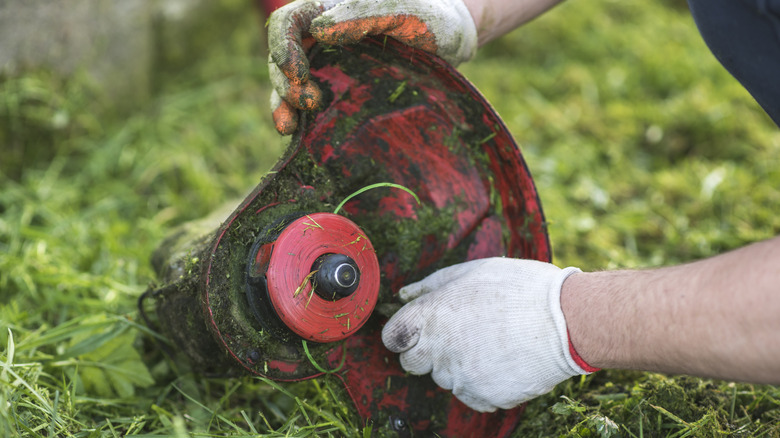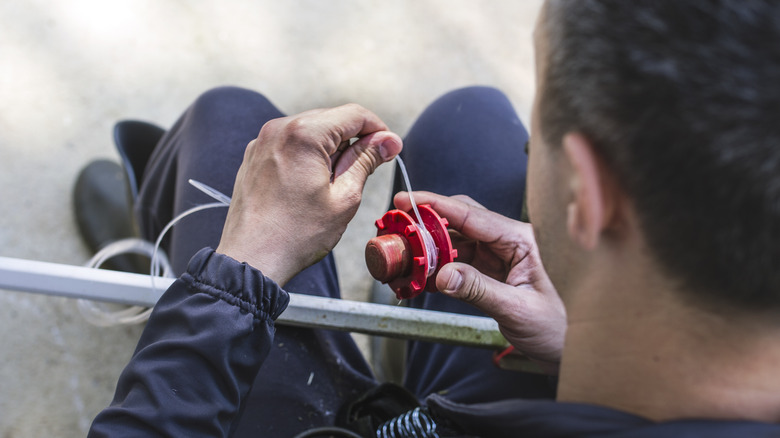No matter how carefully you mow your lawn to keep weeds from taking over, there are always going to be a few spots where you can’t mow quite tightly enough to catch all the weeds. For those areas, you need to deploy a string trimmer, which provides more control in tight areas, ensuring you don’t cut down the plants you want to keep. Using your weed whacker the right way creates razor-sharp edges and delivers the beautiful landscaping you are seeking. To achieve the best results, though, you may need to restring the weed whacker occasionally, allowing you to make those precise cuts. It’s not an overly difficult process, but doing it incorrectly could leave the machine inoperable — and you feeling frustrated.
When the trimmer runs out, you have the option of purchasing a spool that already contains the string that you need wound onto it. You can then just pop the spool into place and continue working. However, you can save quite a bit of money by restringing it yourself using a large quantity and cutting it to fit the small spool that is on the trimmer. You simply purchase the correct gauge of line that matches your model of trimmer and purchase it in a large quantity. You then wind it tightly onto the existing spool for your trimmer and begin using the machine again. Because you’re reusing the spool that’s on the trimmer, you don’t have to worry about finding the manufacturer’s recommended size of replacement.
Starting steps for replacing the string on your weed eater spool

String trimmer lines for a weed whacker are available in multiple thickness diameters, also called gauges. These diameters can range from 0.065 of an inch to 0.110 of an inch and larger. Most lines are round, although some have a twisted, star, or square design. Pick the right gauge and shape to match what your manufacturer recommends. If you use a line that’s too thick and heavy, the machine may struggle to spin it fast enough to be effective. Many machines can handle multiple gauges of line, though.
Once you have the correct large quantity of trimmer line selected, look closely at the mechanism on the underside of the weed eater. Figure out how it’s supposed to look when installed correctly. Take a photo with your smartphone before you take it apart, so you can easily reinsert it.
You’re now ready to remove the existing spool from the machine. Many times, the unit will have a cap or cover that protects the spool. Most caps will pop out of place by simultaneously pressing tabs on either side of the cap and pulling it away from the base of the machine. However, your model may have screws or bolts that hold it in place. If you simply cannot figure out the removal process for the cap, look at the user manual for the weed whacker. If you don’t have a printed user manual, visit the manufacturer’s website.
Adding new string to the weed whacker’s spool

While holding the spool, look at how the remaining chunk of line attaches to the spool. Take a picture so you can attach the new line in the same way. Most use a tiny hole into which you insert the tip of string, and an automatic clip on the inside grips it tight. Others may have a clip on the outside, and you’ll thread the new piece under the clip. Once you are sure how to attach the new line, remove the chunk of remaining string.
You’re ready to cut a new piece from the replacement line. The exact length to use will depend on the model of weed eater that you have, but anywhere from 8 feet to 25 feet is possible. If you want to avoid waste, stick to the lower end of this range. If you have a dual-string trimmer, meaning the line comes out of two holes on the spool, cut two new pieces that are each the same length.
Clip on the new piece. Now begin winding the string onto the spool by hand, keeping it tight and following the arrows printed on the plastic of the spool. If you have two pieces, insert each of them at the same time and hold them together as you wind them. Reattach the spool and stick part of the end of the line out of the matching hole in the weed whacker’s head.